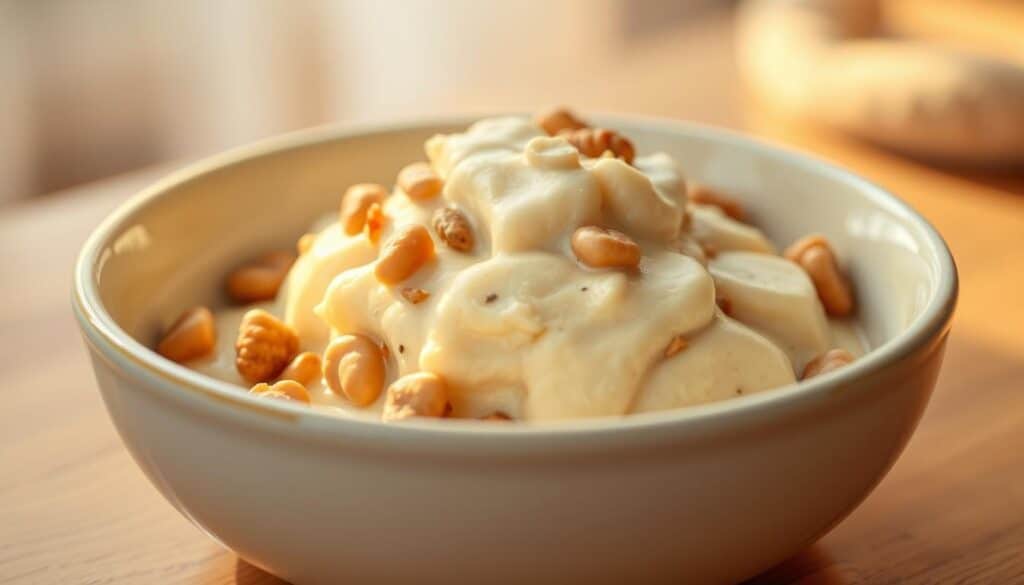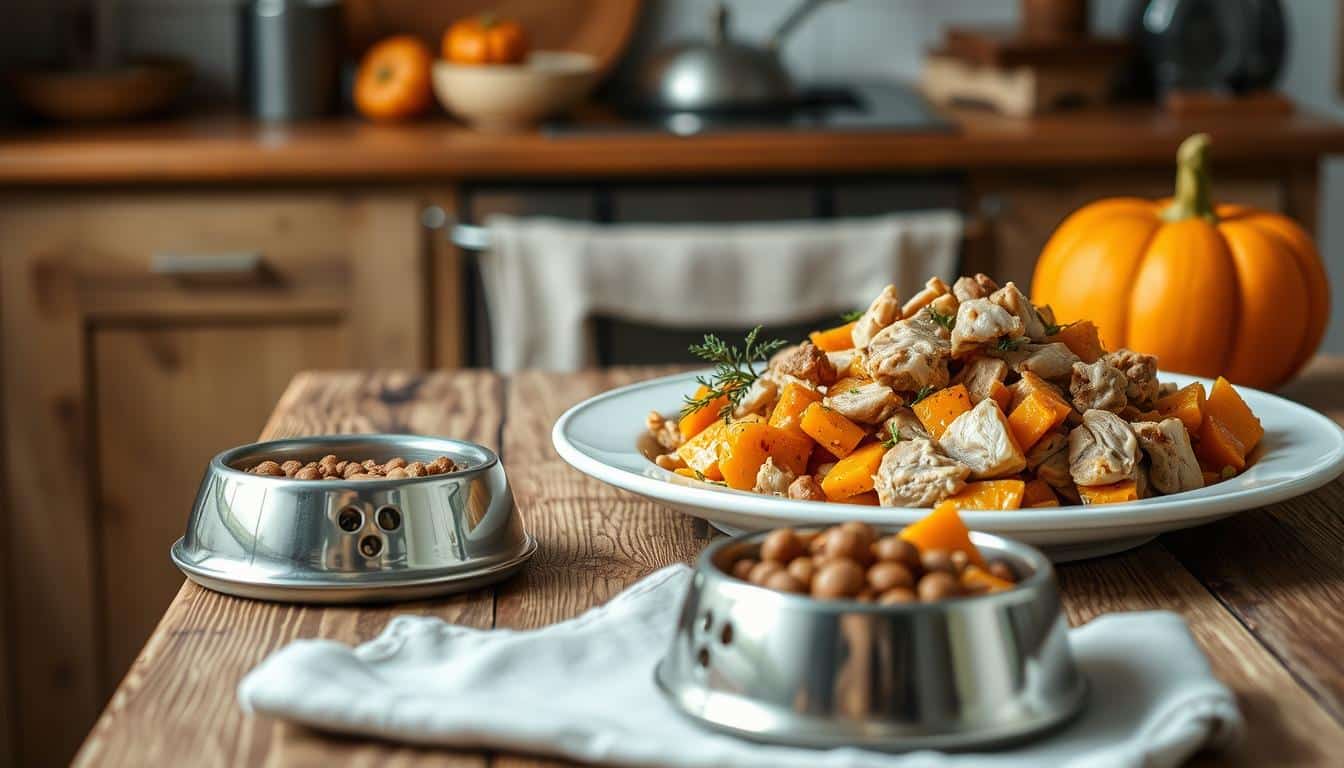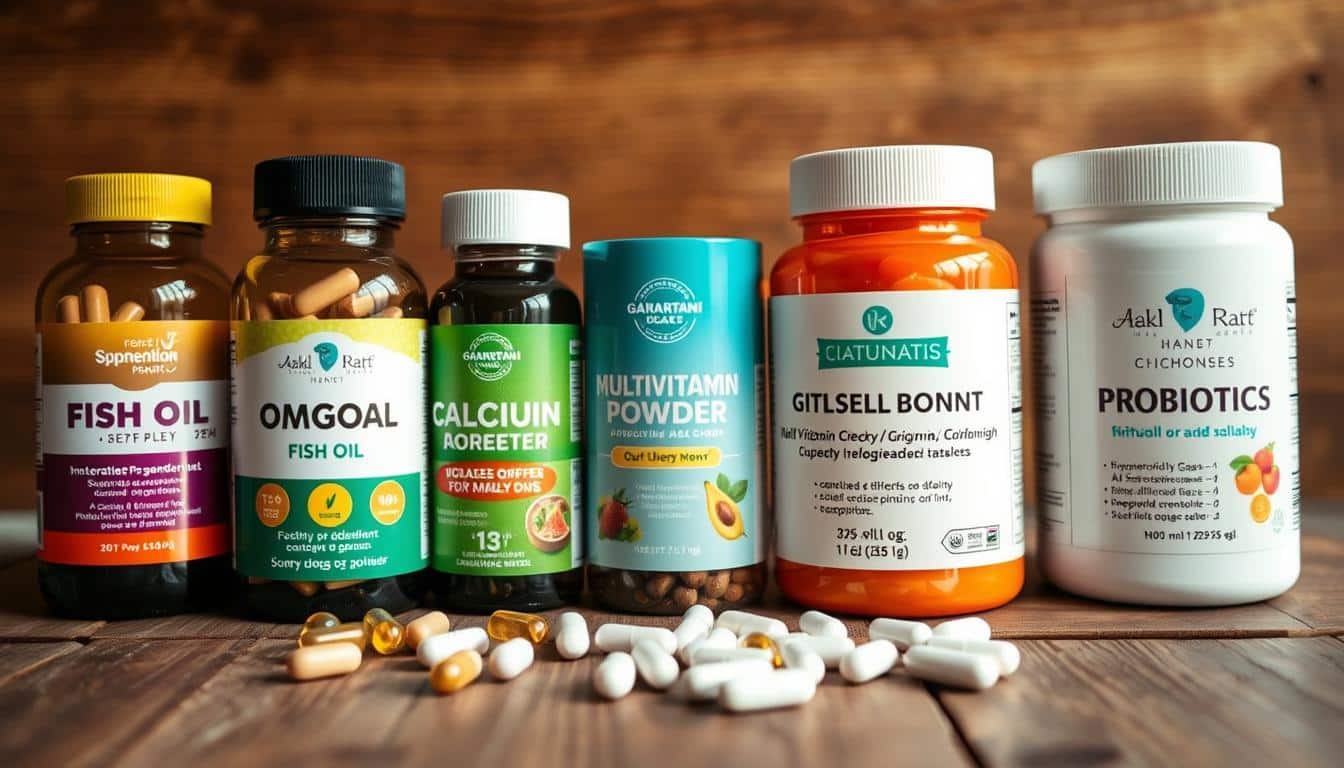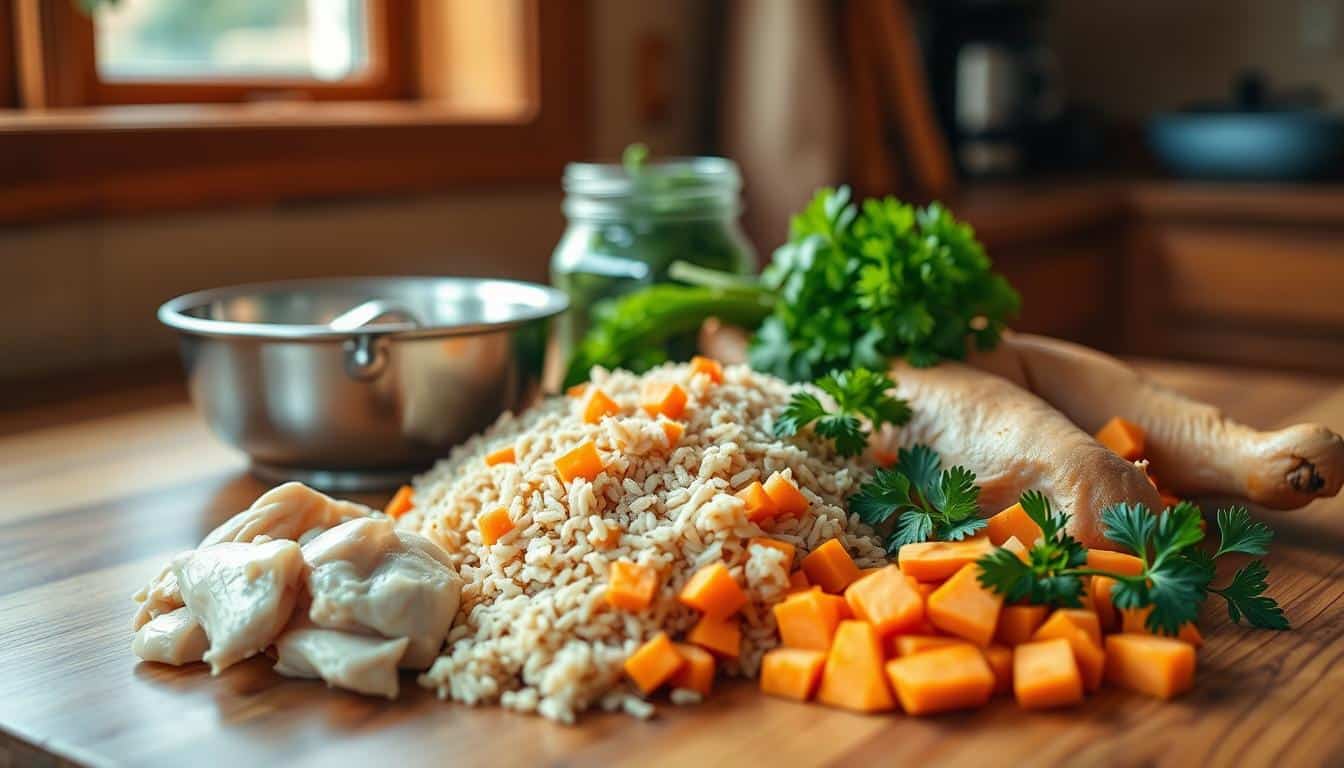Small dogs need different food as they get older. Owners of Chihuahuas, Yorkshire Terriers, and Dachshunds often seek advice. They want to know about low-fat meals for their aging pets to keep them healthy and active.
This article shares tips for low-fat meals for senior dogs. It talks about using lean proteins, easy-to-digest carbs, and adding moisture to help with chewing and digestion. Freshpet’s recipes for older dogs are good examples. They’re made in the USA and include visible proteins and veggies, plus added benefits for joints and brains.
Homemade food can be better for dogs with food allergies. Many owners notice less scratching when they use simple ingredients from the store. Yet, vets from Chewy suggest customizing the diet. Some older dogs might need less calories or special supplements.
In this guide, you’ll find ideas for low-fat meals for senior dogs, lists of safe ingredients, and tips for how much to feed small breeds. The aim is to make meals that are easy, healthy, and right for your dog’s needs without extra fat or trouble.
Understanding Nutritional Needs of Small Senior Dogs
Small breeds start showing signs of aging around 10–12 years. They may eat less, move slower, and look different. Checking their activity, weight, dental health, and any long-term illnesses is the first step. This helps you decide how many calories and what nutrients they need every day.
How aging changes metabolism and activity
As dogs get older, their metabolism slows down. This means they can’t burn off energy like they used to. If you don’t adjust their food, they might gain weight. Look out for signs like less interest in walks and wanting to sleep more. These are hints that it’s time to change their diet.
Protein needs versus calorie needs for seniors
It’s important to keep older dogs’ muscles strong. Studies show that they need more amino acids, which come from proteins, to do this. So, even as they eat less, their food should have plenty of good quality protein. This helps them stay strong and move easily.
Many older dogs need fewer calories. But, their diet should still have enough protein. Some foods are made especially for senior dogs. They have less energy but more protein to keep muscles without making the dog fat. Always look at how fit your dog is rather than just their age when giving food amounts.
When to consider lower calories or targeted supplements
Only cut down on food if your dog is putting on weight or moving less. Reducing calories too much can actually harm their muscles. It’s better to make specific changes for certain issues.
- For sore joints, think about supplements with glucosamine and chondroitin.
- Omega-3 fatty acids like EPA and DHA are good for inflammation and brain health, and they don’t make dogs fat.
- Before adding supplements or special diets, talk to a vet to make sure you get the amount and type right.
Make a custom plan for each dog. Find the right balance between how many calories they need and how much protein they should get. Also, add supplements only for specific problems. This careful planning helps keep your dog at a healthy weight, strong, and happy.
Low-fat homemade meals for small senior dogs
Making dog food at home for your small senior dog can lower their calorie intake while keeping meals tasty. A steam-cooking method keeps the nutrients in and makes the food softer. This is something older dogs can chew better. It’s important to measure food and use the right ingredients to help them move easily and maintain a healthy weight.
Benefits of low-fat homemade diets for weight management
Low-fat meals mean dogs get fewer calories, which is good for keeping their weight in check. By controlling portions and adding fiber, your pets can feel full even though they’re eating less. Also, carrying less weight helps reduce the strain on their joints, making it easier for them to move around.
Balancing lean protein, fiber and moisture for small breeds
Using lean protein like chicken breast, ground turkey, or white fish helps maintain muscle without adding too many calories. Combine these proteins with fiber-full vegetables and grains. This makes your dog feel full without needing fat.
Add lots of water to your dog’s meals to help them stay hydrated and not eat too many calories. Vegetables that have been steamed and a little canned pumpkin can add moisture. They also make digestion easier. Softer and moister food is often more appealing to picky older dogs.
Sample ingredient list for safe low-fat homemade recipes
- Skinless chicken breast and lean ground turkey for primary protein
- White fish or small portions of salmon for occasional omega-3s
- Egg whites and low-fat cottage cheese in moderation
- Cooked brown rice, rolled oats, and sweet potato as low-glycemic carbs
- Carrots, green beans, spinach, and peas for fiber and vitamins
- Plain canned pumpkin for soluble fiber to aid digestion
- Small, vet-recommended fish oil dose for EPA/DHA
- Glucosamine/chondroitin supplements if approved by your veterinarian
When making your dog’s food, choose items that are safe for them and preferably human-grade from the U.S. Avoid harmful ingredients like onions, garlic, grapes, raisins, and xylitol. Start with new foods slowly and keep an eye on how your dog reacts, especially their skin, coat, and poop. Using safe ingredients and controlling portions is crucial for your dog’s long-term health.
Top lean protein sources and portion guidance for small seniors
Choosing the right proteins helps small senior dogs keep muscle, support joints, and stay active without extra calories. Look for low-fat, easy-to-digest options and plan meals based on your dog’s weight and activity level. Keep an eye on their shape and talk to your vet about what proteins are best for them.
Safe poultry and fish are packed with good amino acids. Skinless chicken breast and plain turkey are great for lean protein. Small servings of salmon can boost brain and joint health, so add a bit of salmon or a supplement to watch calorie intake.
Lean red meats and dairy alternatives are good too. Try 90% lean beef, low-fat cottage cheese, and some cooked eggs. Stick to mostly egg whites to cut fat and sprinkle in some yolk if calories aren’t a problem.
- chicken for senior dogs: skinless breast, poached or baked, no seasonings.
- turkey for dogs: lean ground or white meat, cooked through.
- salmon omega-3 dogs: small portions twice weekly or fish oil drops as directed.
- lean beef and cottage cheese: occasional servings to avoid excess fat.
- eggs: fully cooked, whites preferred; yolks in moderation.
Start with calorie targets for small breeds. Senior feeding charts often suggest ½ to 1¼ cups daily for dogs 6–20 lb. To fit homemade meals, calculate total calories of the recipe and divide by your dog’s calorie needs.
Senior dogs might need more protein than adults. Research and vets say more protein helps maintain muscle. Work with your vet to figure out the right amount of protein for your dog’s health.
- Weigh your dog and figure out daily calorie needs.
- Work out recipe calories and protein per serving.
- Adjust food amounts to meet protein needs without overdoing calories.
Keep an eye on your dog’s weight and muscle shape, and change food amounts as needed. Using chicken, turkey, and controlled salmon portions helps keep meals healthy without extra fat. Focus on lean proteins and regular vet visits to adjust food over time.
Low-fat carbohydrate and vegetable options that support digestion
Choosing gentle, low-fat carbs for dogs helps keep blood sugar stable. It also keeps calories low for small senior pets. Pairing these carbs with fiber-rich vegetables makes dogs feel full and helps with digestion. This is important as dogs get older.
Whole grains and alternatives
Brown rice provides consistent energy and is easy for dogs to digest. Rolled oats, when cooked until soft, add soluble fiber without adding fat. Sweet potatoes are full of vitamins A and C, and they help dogs feel full.
Vegetables for fiber and nutrients
Some vegetables that are good for senior dogs include carrots, green beans, and spinach. These veggies are high in vitamins and fiber but low in calories. Plain canned pumpkin is gentle on stomachs and helps with bowel movements.
Steam-cooking to retain nutrients and aid digestion
Steam-cooked food keeps in the vitamins and is easy for senior dogs to chew. It makes starches and veggies easier to digest and often tastes better than dry food.
- Thoroughly cook brown rice and oats before serving to improve digestibility.
- Trim fat from proteins and avoid raw beans that may be hard to digest.
- Introduce new low-fat carbs for dogs slowly and watch stool quality closely.
It’s important to find the right balance: mix lean protein with easy-to-digest carbs and dog-safe veggies. This mix helps with digestion and keeps senior dogs at a healthy weight.
Incorporating joint and cognitive support without extra fat
Small senior dogs can improve their movement and brain health without extra calories. Nutrients like glucosamine help with joint support in senior dogs. At the same time, they keep fat and weight in check.
Choose supplements that focus on active ingredients to avoid high-fat foods. Glucosamine and chondroitin for dogs are often available in low-calorie chewables. Always pick products from reputable brands and follow the recommended dosage.
For cognitive health and reducing inflammation, omega-3 DHA and EPA are essential. Fish oil capsules or liquids provide these without adding too much fat. Your vet can help decide the correct EPA/DHA amount based on your dog’s specific needs.
- Compare capsule versus liquid forms to find the easiest delivery for small breeds.
- Pair glucosamine with chondroitin supplements when recommended to support cartilage resilience.
- Track calories from any supplement to keep low-fat supplement strategies senior dogs effective.
A vet’s advice is crucial to avoid giving your dog too many supplements or causing drug interactions. They can suggest special diets or therapies to help. It’s important to adjust doses for any existing health issues.
Watching how your dog walks, plays, and sleeps can show if there’s progress or any negative reactions. Go for trusted brands, follow the directions, and use strategies that don’t add extra fat. This way, you support their joints and mind without causing weight gain.
Textures and presentations for small senior dogs with dental issues
Older small-breed dogs often have dental wear and missing teeth. These problems can make chewing hard. Offering foods that are soft and warm can help. These foods are easy to eat and help keep their mouths from hurting.
Use meals that are steam-cooked and blends that are soft. This makes it easier for them to chew. It also helps them get more nutrients from their food.

Soft, steam-cooked mixes and moisture-rich recipes
Steam-cooked meals make proteins soft and veggies easy to mash. Make sure to prepare small portions. They should be lightly pulped or finely chopped to fit tiny jaws.
Recipes rich in moisture are great. They don’t need much crunching. This soothes their gums and helps with hydration, especially for those that drink less.
Mixing wet and dry food for hydration and palatability
Mixing wet and dry food can help with taste and texture. A mix that’s half wet and half dry provides hydration. It also ensures a soft texture.
Some kibble is good for encouraging chewing. Wet and dry mixes appeal to picky eaters. They make meals more interesting.
Transition tips to reduce digestive upset when changing texture
When changing food textures, do it slowly to avoid upset stomachs. Start with a mix of 25% new food and 75% old food. Do this for a few days.
Then, change to a 50/50 mix. Finally, shift to 75% new food. This should be done if their stool is normal and they’re eating well. Gradual changes are often best for dogs.
- Serve steam-cooked bowls lukewarm and check temperature before offering.
- Keep portion sizes small; tiny breeds need bite-sized servings that match jaw size.
- Refrigerate opened wet food and discard leftovers after recommended times.
- Watch dental issues senior dogs closely; switch to softer formats if chewing worsens.
Recipe ideas and feeding guidelines tailored to small breeds
Small senior dogs need foods that are easy on their joints, simple to chew, and not too fatty. Below are balanced, steam-cooked meals suitable for small, frequent servings. It’s wise to consult a vet for advice on homemade diets and nutrient requirements.
Low-fat chicken and vegetable steam-cooked bowl — sample proportions
- Ingredients for a batch: 2 lbs chicken with no skin, 2 cups brown rice cooked, 2 cups carrots steamed, 2 cups green beans steamed, 1/2 cup plain canned pumpkin, and maybe a small dose of fish oil from the vet.
- Preparation: Cook the chicken and veggies till they’re soft. Shred the chicken for tiny mouths. Combine rice and pumpkin for added fiber and moisture. Let it cool before you serve it.
- Portioning tip: Figure out the calories for the whole batch, then divide by daily needs. This recipe is moist and easy to eat for older dogs with dental issues.
Turkey and brown rice mash with green beans — weight-control focused
- Ingredients: 1.5 lbs of lean turkey (remove extra fat), 2 cups brown rice cooked, 2 cups green beans cooked, 1/2 cup sweet potato cooked, and optionally 1/4 cup of low-fat cottage cheese.
- Preparation: Cook the turkey well, mix with rice and veggies, and mash it so it’s easy to chew. Steaming helps keep nutrients in and makes it easier to digest.
- Weight-control notes: Use lean turkey and lots of veggies for a filling, low-calorie meal. This mash is good for keeping dogs feeling full and managing their weight.
Feeding portion recommendations and adjustments
- Start with feeding charts designed for senior dogs. For instance, dogs weighing 6–20 lbs might eat ½–1¼ cups each day, with each cup having around 405 kcal. Homemade meals need their calories worked out.
- How to calculate: Work out the calories for every ingredient, add them up, then divide by the dog’s daily calorie needs. A small kitchen scale can help you be precise.
- Check the dog’s weight and activity level each week. If the dog puts on weight or moves less, give smaller servings or replace part of a meal with veggies that have fewer calories. It’s key to adjust slowly and keep regular tabs on their health.
- If you’re unsure, ask a vet or a pet nutrition expert for exact calorie needs and a balanced diet plan. Controlling portions helps keep senior dogs fit, their joints in good condition, and avoids strain from too much weight.
Monitoring health: when to consult your veterinarian
Keep an eye on aging small dogs for any gradual changes affecting their daily activities. Taking early action is crucial for treatment and diet adjustments. Schedule a visit with the vet if you see ongoing issues.
Look out for signs that may require changes in diet. Sudden weight changes, difficulty with moving, frequent diarrhea or vomiting, and ongoing skin issues are major concerns. Also, pay attention to changes in appetite, sleep, or focus as these could mean metabolic or cognitive issues. Contact your vet right away if you see any worrying signs.
Certain health problems need specific diets, sometimes prescribed by the vet. For example, senior dogs with kidney disease do well on diets with less phosphorus and controlled protein levels, like Hill’s Prescription Diet k/d. Heart issues might benefit from low sodium and special nutrients found in Royal Canin Veterinary Diet Early Cardiac. Diets high in glucosamine and chondroitin help dogs with joint pain. And for dogs with sensitive stomachs, try limited-ingredient diets like Purina Pro Plan Sensitive Skin & Stomach. Always discuss food changes with your vet first.
Switching to a new diet requires patience. Begin by mixing 10% new food with 90% of the old food. Gradually increase the new food over a week or so, while keeping an eye on how your dog reacts. Follow your vet’s advice on diet changes, especially if your dog reacts poorly. When adding new supplements, make sure to get advice on the proper amount to avoid any issues.
If you’re making your dog’s meals at home, work with a nutrition expert. This ensures your dog gets all the right nutrients. Some older dogs can stick to their regular diets if their weight and health tests are good. But talk to your vet about whether your dog might need a special diet for better health.
- Signs to call the vet: weight change, mobility decline, persistent digestive issues, skin problems, appetite drop, cognitive shifts.
- When prescription diets may be needed: kidney, heart, joint, or severe digestive conditions.
- Safe transitions: 7–10 day gradual swap, monitor stool and appetite, consult on supplements and homemade meal balance.
Conclusion
When you make low-fat meals at home for small, older dogs, focus on lean meats, fiber-filled veggies, easy-to-digest carbs, and lots of water. These ingredients help with weight, digestion, joint health, and making the food taste good. Cooking with steam keeps the nutrients in and makes the food soft for dogs with bad teeth, and keeping protein high protects their muscles as they become less active.
For an older dog’s diet, stick to lean meats like skinless chicken and turkey. Add fatty fish or fish oil for brain health, and include brown rice, oats, or sweet potatoes. Also, add carrots and green beans for fiber and vitamins. Use supplements like glucosamine and chondroitin with your vet’s okay to keep your dog moving well without adding too many calories.
It’s important to watch how homemade food affects your senior dog. Keep an eye on their weight, how well they move, the quality of their coat, and their bathroom habits. Talk to your vet or a pet nutrition expert to make sure your dog gets the right amount of calories and protein. Since “senior” can mean different things for different dogs, getting advice from a pro is key to make sure your dog stays healthy and happy.
FAQ
What nutritional changes happen as small dogs enter their senior years?
Do senior dogs need more protein or fewer calories?
When should I switch to a lower-calorie senior formula or use supplements?
What are the main benefits of low-fat homemade meals for small senior dogs?
How do I balance lean protein, fiber, and moisture in homemade meals?
What safe, low-fat ingredients should I keep on hand?
Which lean proteins are best for small senior dogs and how much should I feed?
How can I provide omega-3s and joint support without adding too much fat?
Which carbohydrates and vegetables aid digestion and satiety in seniors?
Why steam-cook ingredients and how should I prepare meals for easy chewing?
Can homemade meals help if I suspect a commercial food is causing skin or digestive issues?
How do I transition my senior dog to a new homemade diet without upsetting digestion?
What sample homemade recipes fit small senior dogs focused on weight control?
How should I calculate portions and monitor weight for a small senior dog?
When should I consult my veterinarian about diet or prescription foods?
Are commercial senior foods ever appropriate instead of homemade meals?
How do I add supplements safely to a homemade senior dog diet?
Content created with the help of Artificial Intelligence.



